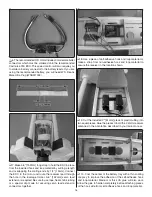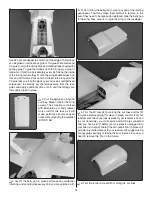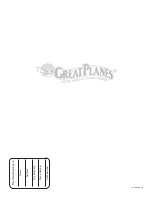
26
Landing
To initiate a landing approach, lower the throttle while on the
downwind leg. Allow the nose of the model to pitch downward
to gradually bleed off altitude. Continue to lose altitude, but
maintain airspeed by keeping the nose down as you turn onto
the crosswind leg. Make your fi nal turn toward the runway (into
the wind) keeping the nose down to maintain airspeed and
control. Level the attitude when the model reaches the runway
threshold, modulating the throttle as necessary to maintain
your glide path and airspeed. If you are going to overshoot,
smoothly advance the throttle (always ready on the right rudder
to counteract torque) and climb out to make another attempt.
When you’re ready to make your landing fl are and the model
is a foot or so off the deck, smoothly increase up elevator until
it gently touches down. Once the model is on the runway and
has lost fl ying speed, hold up elevator to place the tail on the
ground, regaining tail wheel control.
One fi nal note about fl ying your model. Have a goal or fl ight
plan in mind for
every
fl ight. This can be learning a new
maneuver(s), improving a maneuver(s) you already know,
or learning how the model behaves in certain conditions
(such as on high or low rates). This is not necessarily to
improve your skills (
though it is never a bad idea!)
, but more
importantly so you do not surprise yourself by impulsively
attempting a maneuver and suddenly fi nding that you’ve run
out of time, altitude or airspeed. Every maneuver should be
deliberate, not impulsive. For example, if you’re going to do a
loop, check your altitude, mind the wind direction (anticipating
rudder corrections that will be required to maintain heading),
remember to throttle back at the top, and make certain you
are on the desired rates (high/low rates). A fl ight plan greatly
reduces the chances of crashing your model just because
of poor planning and impulsive moves.
Remember to think.
Have a ball! But always stay in control
and fl y in a safe manner.
GOOD LUCK AND GREAT FLYING!
TRIMMING THE PROUD BIRD
FOR RACING
“The NMPRA developed the Electric Formula 1 class to fi ll a
need for a fun racing class that would be a great way for RC
pilots interested in trying racing to give Pylon a try and for
experts to have some laid back fun with cool looking planes
that are reasonably priced, easy to operate and also fun to
sport fl y. The rules are also specifi cally written to keep the
planes relatively equal with specifi c approved motors and
tightly controlled model designs and batteries. Those goals
have been met and exceeded.
You can fi nd out more about this type of racing and the
organization at the NMPRA web site: www.nmpra.org
The full set of rules is available on the site at: http://www.
nmpra.org/rules.htm
Racing your Proud Bird in NMPRA EF-1 class can be a great
time but, it can be even better when the plane is properly setup
and trimmed to make it as easy as possible to get around the
course quickly and consistently. It all comes down to doing
the little things that improve your lap times. The easier it is
to fl y those fast lap times consistently, the better your heat
times will be. We’re going to walk you through the process of
trimming your Proud Bird to allow you to make the most of
the great fl ying qualities of this plane.
Let’s start by carefully setting an initial center of gravity fore
and aft to be within the range specifi ed earlier in this manual.
Play with battery location in the compartment as much as
possible to get the CG to the desired location without adding
weight, if at all possible. If you have the battery as far back
as possible in the battery compartment and you’re still nose
heavy, use stick on weights under the horizontal stab, as far
back as possible. You’ll want to establish the position where
your battery pack needs to be to get the CG in the desired
position and mark it so you can repeat the position each time
you install the battery. If you have battery packs that weigh
different amounts, they’ll need to be placed in different locations
in the compartment to achieve the same CG. You may end up
fi ne tuning the CG forward or aft to adjust the way the plane
fl ies on the course but we’ll get to that shortly.
Now, check the lateral balance of the plane, side to side, by
picking up the plane by the prop shaft and the top of the
vertical fi n or lifting under the tail end of the fuselage (not
on the movable rudder) to see if the plane is heavier on one
side or the other. If it is, add weight to the light tip to get it
as close as possible. Taping coins to the lower wing surface
works well or you can use lead tape, available at golf stores
or online. Again, this may end up being adjusted more based
on the way the plane fl ies later.
Next, you need to set up your control throws. The control
defl ections that you use for sport fl ying will usually be more
than is needed or wanted for racing. Every time you move a
control surface you increase the drag of the airplane slightly
and it slows down. The more you move those control surfaces,
the more you slow down. Minimizing how much you move the
controls while maintaining a tight course will always result in
faster lap times. Learning to fl y those faster laps consistently
will result in faster heat times. Set your throws with low rates
as recommended in this manual. That will be a good place
to start. You can use the higher rates for sport fl ying or for
landing in windy or bumpy conditions.
You should now be ready to get the plane in the air and see
how it fl ies. Go fl y the plane and get it trimmed well for straight
and level fl ight. Throughout the trimming process, you will
always want to do this fi rst and after each change you make.
Always re-trim for level fl ight. This is very important. Make long,
level passes starting with the nose and wings level and get it
trimmed very well before you think about fl ying it on the course.
Whether you are racing a 2-pole course while standing
alongside the runway or the 3-pole course standing in the
middle near pylons 2 and 3, you still need to make your turns
as effi cient as possible. Pulling on the elevator too hard will
cause too much increase in drag and result in the loss of

















